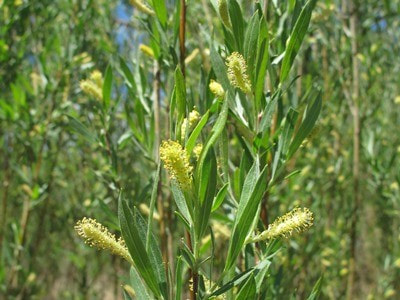|
Found in moist areas, ditches, stream banks
Seen blooming in June by the Rio Chama Coyote Willow is very common and only one of the several varieties of willow that grow in our area. It grows to ten feet tall in thickets with yellow, red and tannish stems. The leaves are long, up to five inches, very narrow and shiny. They have tiny flowers with no petals in dense spikes called catkins with male and female flowers on separate plants. The male catkins point up, the females droop down. The photo is of male flowers loaded with pollen. The female produces masses of fluffy seeds. The fresh bark of all members of this genus contains salicin which decomposes into salicylic acid (closely related to aspirin) in the human body. Traditionally, the bark was used to treat fevers, coughs, venereal diseases, and sore throats, and was taken as an emetic. Branches were used for building sweat lodges for rheumatism and colds; the young twigs were used to make baskets, mats, and cordage. The fibers in the bark have been woven to make clothing, bags and blankets. The shredded inner bark has been used to make sanitary towels and babies' nappies. The twigs have been used as toothbrushes. Source. If you are trying to identify a different flower then you can check what other flowers bloom this month. If you cannot identify a flower from the website, send a photo and where you took it to [email protected]. Read online for tips.
0 Comments
Leave a Reply. |
AuthorI am Marilyn Phillips, a native of England, whose love of nature and the outdoors from childhood brought me by a circuitous route to Crested Butte, Colorado in 1993 and 16 years later to northern New Mexico. My exploration of the many trails in these areas, my interest in wildflowers and photography, and career in computer system design came together in this creation. If you have any corrections, comments or questions, please contact me by email. Archives
September 2025
Categoriescopyright © 2020
|



 RSS Feed
RSS Feed